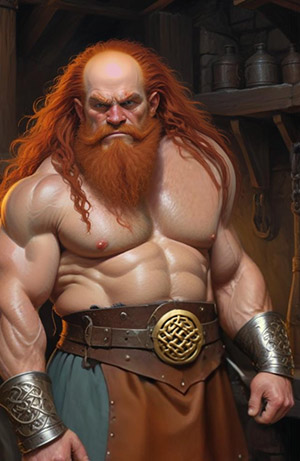Hephaestus is the god of blacksmithing, fire, and crafts. Hephaestus is a patron of all the civilized arts, though smiths are his special charges. Bards' tales say that volcanoes mark the sites of his forges. He was also known as Vulcan in Rome.
Despite being ugly and deformed, Hephaestus is highly honored among the gods as their armorer and smith. He served as the blacksmith of the gods, and was worshipped in the manufacturing and industrial centers of Greece, particularly Athens. The cult of Hephaestus was based in Lemnos.
Clerics of Hephaestus are charged with maintaining civic life. They perform a wide range of public ceremonies, most importantly welcoming children into family and community. They also see to educating the young and especially to training apprentice smiths and other craft workers.
Temples
Every temple or shrine of Hephaestus has a fire that is kept perpetually lit, and most include a smithy or other workshop. Hostels and sanctuaries for the infirm and the handicapped are also common.
Hephaestus is a peaceful deity who teaches the value of hard labor, honesty, dependability. He emphasizes loyalty to family and to whomever else loyalty is due: superiors, just rules, and elders most of all. He encourages his followers to tackle their problems with vigor and persistence, like smiths hammering bits of metal into more desirable shapes.
Hephaestus, usually appears as a tall, bearded giant with a club foot and a hunchback. Among the comely gods of Olympus, only he is ugly.
Hephaestus is married to Aphrodite but secretly loves Athena, who either does not notice or does not deign to acknowledge his affection. He was either the son of Zeus and Hera or he was Hera's parthenogenous child.
In one branch of Greek mythology, Hera ejected Hephaestus from the heavens because he was "shrivelled of foot". He fell into the ocean and was raised by Thetis (mother of Achilles and one of the 50 Nereids) and the Oceanid Eurynome.
In another account, Hephaestus, attempting to rescue his mother from Zeus' advances, was flung down from the heavens by Zeus. He fell for an entire day and landed on the island of Lemnos, where he was cared for and taught to be a master craftsman by the Sintians – an ancient tribe native to that island.
Hephaestus is one of the Olympians to have returned to Olympus after being exiled. Dionysus intoxicated Hephaestus with wine, and took the subdued smith back to Olympus on the back of a mule accompanied by revelers

